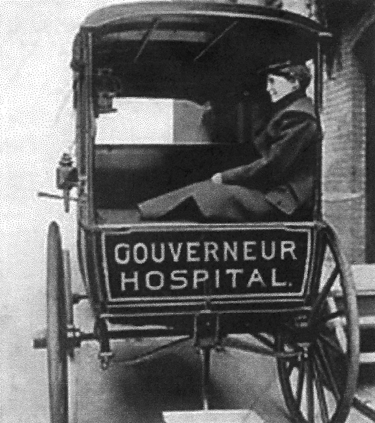
“Memories of the shadowy night, Ah, dearest, truest, best of friends, still come and cluster round my head, when weary with the fight of life, I sink to rest and Ah, come back then.”
—Emily Dunning, M.D. 1901
Time brings great changes.
Those living today may wonder just how it could have been that women were not allowed to vote, own property, or to be considered property of their fathers and husbands. Who decided this fate and when and why?
And thus it was regarding Emily Dunning, M.D., birth, September 27, 1876. Turner Classic Movies ran a film entitled “Lady in White” about her struggles to practice her profession at the Gouverneur Hospital in New York City.
Then I became aware of her autobiography entitled “Bowery to Belleview: A Story of New York’s First Woman Ambulance Surgeon” which was published in 1950. The book came to Aurora as an inter-library loan from the Illinois State Library in Springfield upon my request. What a wonder! I must ask how it arrived by mail or another transit? I was thrilled to have the book in my hand and to read her words.

Submitted photo
Emily Dunning Barringer was born to a wealthy New York family that fell on hard times when she was 10 years old. Her father left for Europe to try to recoup his fortune, and left her mother with five children. Because of her uncle Henry W. Sage, a founder of Cornell, University in Ithaca, N.Y., who agreed to pay her tuition, she attended the College of Medicine on the New York Infirmary beginning in 1894. She earned her medical degree in 1901 and received the second highest grade in the qualifying exam for an internship at Gouverneur Hospital.
However, the hospital denied her application. She re-applied the following year with the support of political and religious leaders and the hospital accepted her. She was the first woman accepted for post-graduate surgical training in service to a hospital. In the USA at that time there were less than 600 women physicians. Men doctors numbered 7,400. Elizabeth Blackwell, M.D., had to wear male clothing to continue her studies and become a physician in 1847.
In some of the latest statistics available, in 2013 there were 1,045,910 doctors for a U.S. population of more than 350 Million. There were 148,000 inactive doctors. The average male salary was $256,224 and the female salary was $177,936.
In Emily Dunning’s case, fellow medical residents assigned her the most difficult “on call” schedules and ward duties and even harassed her during mealtimes. A woman doctor was an anomaly for the Lower East Side neighborhood in New York City where she worked. But she was indefatigable and continued to give the best medical care she could. In her autobiography she wrote that “the beds were with every kind of man from the waterfront—old men, sailors, longshoremen, hucksters, tramps, and gangsters.” Bystanders would shout “Get a man. Get a man.”
She took a position on the gynecological staff at New York Polyclinic Hospital. She was an attending surgeon at Kingston Avenue Hospital in Brooklyn and later its director of gynecology.
She was married to Dr. Benjamin Barringer the day after she finished her residency in 1904. They had two children, Benjamin and Velona. During World War I she served as vice chair of the American Women’s Hospitals War Service Committee of the National Medical Women’s Association. She helped raise money for ambulances to be sent to Europe.
Emily Dunning Barringer, M.D. died April 8, 1981 at age 84 in New Canaan, Conn..

